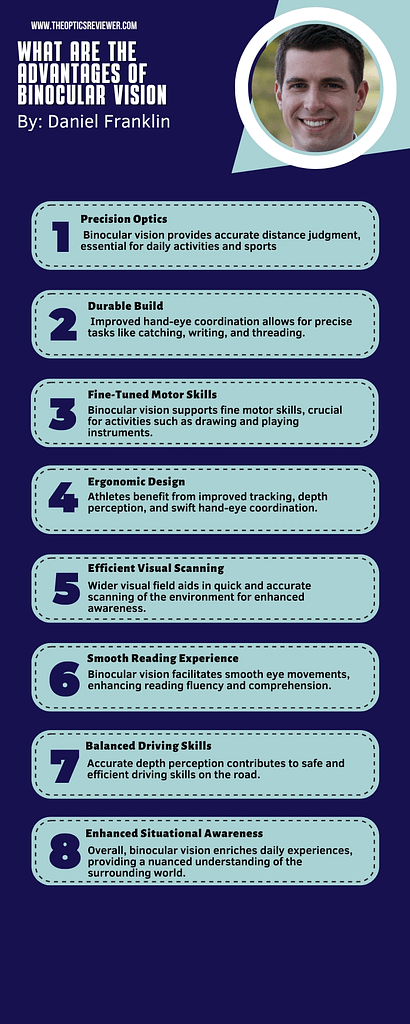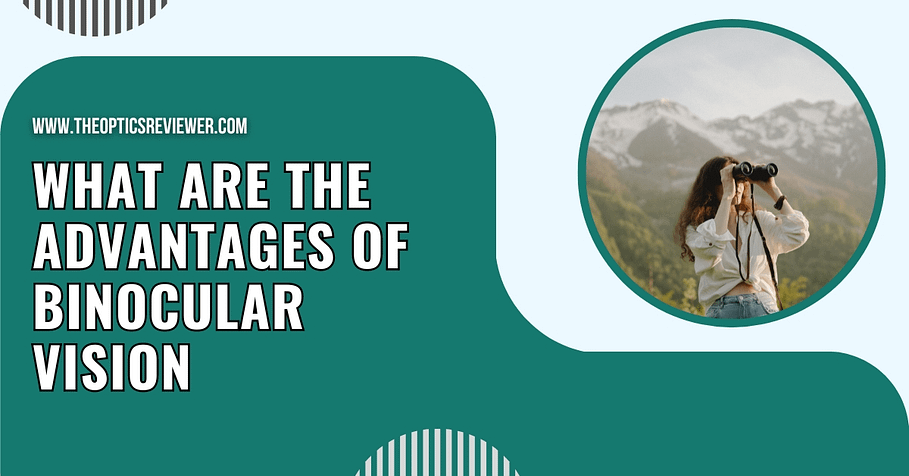Embark on a visual journey as we explore the captivating world of binocular vision and unravel the extraordinary advantages it bestows upon us. What Are the Advantages of Binocular Vision is a question that leads us into the intricate realm of how our eyes work in tandem, forging a three-dimensional panorama of our surroundings. Binocular vision, the ability to perceive depth and distance, is a marvel of evolutionary engineering that significantly enhances our daily experiences.
In this comprehensive exploration, we delve into the myriad advantages of this visual phenomenon, from improved depth perception to heightened accuracy in judging distances. Join us in unraveling the mysteries of binocular vision, understanding how this remarkable trait not only shapes our perception but also plays a pivotal role in our survival and interaction with the world around us. Get ready to see the world with new depth and clarity, as we uncover the fascinating advantages bestowed by binocular vision.
Contents
- 1 Key Takeaways
- 2 What is Binocular Vision and How Does it Work?
- 3 What are the Advantages of Binocular Vision?
- 4 What are the Main Grades In Binocular Vision?
- 5 How To Test Binocular Vision?
- 6 What are Some Examples of Performance Skills That Benefit From Binocular Vision?
- 7 Conclusion
- 8 References
- 9 Frequently Asked Questions
- 9.1 Can Binocular Vision Be Improved or Corrected Through Exercises or Therapy?
- 9.2 Are There Any Disadvantages or Drawbacks to Having Binocular Vision?
- 9.3 How Does Aging Affect Binocular Vision and What Can Be Done to Maintain It?
- 9.4 Are There Any Specific Occupations or Activities That Require Excellent Binocular Vision?
- 9.5 Can Certain Medical Conditions or Medications Affect Binocular Vision and How Can They Be Managed?
Key Takeaways
- Enhances depth perception and distance judgment for improved spatial awareness.
- Improves visual acuity and clarity for sharper and more detailed vision.
- Enables 3D vision for realistic and immersive experiences.
- Enhances hand-eye coordination and precision for better performance in tasks requiring coordination.
What is Binocular Vision and How Does it Work?
Binocular vision is the ability of an organism to merge two slightly different images from each eye into a single, three-dimensional perceptual experience, providing depth perception and enhancing visual acuity. This process relies on precise eye coordination to align the images correctly, allowing for accurate depth perception. By combining the inputs from both eyes, individuals gain a heightened sense of spatial awareness, enabling them to accurately judge distances and perceive the world in three dimensions.
Furthermore, binocular vision plays a crucial role in maintaining balance and stability. The brain integrates the information received from each eye to create a cohesive visual field, which aids in orienting oneself in space and coordinating movements effectively. This enhanced perception of depth and dimensionality not only improves visual acuity but also contributes to overall coordination and motor skills. In essence, binocular vision serves as a fundamental mechanism for perceiving the environment in a comprehensive and accurate manner.

What are the Advantages of Binocular Vision?
The integration of visual inputs from both eyes in the process of binocular vision confers numerous advantages that significantly enhance an individual’s perceptual capabilities and spatial awareness.
Unlocking Depth Perception: Binocular vision, the ability to merge images from both eyes, grants us depth perception. This crucial visual advantage enables accurate judgment of distances, a skill vital for activities ranging from catching a ball to driving a car.
Enhanced Visual Accuracy: With binocular vision, our brain receives slightly different images from each eye, allowing it to triangulate and create a more precise and detailed visual experience. This enhances our ability to perceive fine details and improves overall visual accuracy.
Improved Object Tracking: Binocular vision contributes to our efficiency in tracking moving objects. This is particularly beneficial in sports, where quick and accurate tracking of a ball or opponent can make all the difference.
Wider Field of View: By combining the visual fields of both eyes, binocular vision provides a wider field of view compared to monocular vision. This expanded visual range enhances situational awareness, making it easier to detect peripheral movements.
Enhanced Low-Light Vision: Binocular vision improves our ability to see in low-light conditions. The combination of images from both eyes enhances light sensitivity, aiding in activities like nocturnal navigation or stargazing.
Increased Cognitive Processing: The brain’s processing power is optimized by binocular vision, leading to improved cognitive functions. This can result in quicker decision-making, increased reaction times, and heightened overall visual cognition.
Facilitation of Complex Tasks: Binocular vision plays a crucial role in tasks that require hand-eye coordination, such as threading a needle, catching a tossed object, or performing intricate tasks. The synchronized input from both eyes enhances our ability to perform these activities with precision.
Emotional and Social Significance: Binocular vision contributes to our emotional and social experiences. The ability to make eye contact and perceive subtle facial expressions enhances communication, empathy, and social interactions.

What are the Main Grades In Binocular Vision?
The main grades in binocular vision encompass simultaneous perception, fusion, and stereopsis. Simultaneous perception involves the ability to integrate visual information from both eyes seamlessly. Fusion is the process of combining two slightly different images from each eye into a single coherent image, while stereopsis is the brain’s ability to perceive depth and three-dimensionality.
Simultaneous Perception
In the realm of binocular vision, simultaneous perception manifests through the ability to discern two distinct objects concurrently. This capacity involves depth perception, where each eye contributes a slightly different view that the brain integrates to provide a sense of depth. Eye dominance may influence which eye’s input is prioritized.
Visual integration and neural processing play crucial roles in combining the images from each eye seamlessly. Achieving visual harmony and spatial awareness relies on this dual focus, enhancing peripheral vision and overall cognitive benefits. Developing simultaneous perception can improve motor skills through the coordination of visual inputs, making it a fundamental aspect of efficient binocular vision.
If interested you can read more about most expensive binoculars.
Fusion
Simultaneous perception in binocular vision seamlessly transitions into the concept of fusion, which involves the ability of both eyes to amalgamate two slightly different images into a single, cohesive visual representation. Fusion benefits include enhanced depth perception, improved visual integration, better eye coordination, and increased visual acuity.
It allows the brain to create a more detailed and comprehensive image by combining the input from each eye. This process is crucial for activities like driving, sports, and everyday tasks that require accurate depth judgment. By merging the images received by each eye, fusion plays a vital role in creating a unified visual world, enabling us to navigate our surroundings effectively and perceive objects with greater clarity and precision.
Stereopsis
Within the realm of binocular vision, the main grades in stereopsis play a critical role in perceiving depth and spatial relationships with precision and accuracy. Stereopsis enhances 3D vision by combining the slightly different images from each eye, allowing for a more detailed perception of the environment. This process relies on the visual integration of both eyes to create a cohesive image, significantly improving depth perception.
Moreover, stereopsis is closely linked to visual acuity, as it requires the eyes to work together efficiently for optimal depth perception. Eye alignment is crucial for the brain to merge the images correctly, ensuring a seamless and accurate interpretation of the surroundings. In summary, stereopsis is fundamental for depth perception and overall spatial awareness.
- Enhances 3D vision
- Improves depth perception
- Relies on visual integration
- Linked to visual acuity
- Requires proper eye alignment
How To Test Binocular Vision?
Testing binocular vision is important to assess how well both eyes work together for depth perception and a seamless visual experience. Here’s a step-by-step guide on how to test binocular vision:
- Visual Acuity Test:
- Begin with a standard visual acuity test for each eye.
- Evaluate how well each eye sees individually using an eye chart.
- Cover Test:
- Assess eye alignment by using the cover test.
- Ask the person to focus on a distant object while covering one eye; observe for any movement or deviation in the uncovered eye.
- Stereoacuity Test:
- Conduct a stereoacuity test, such as using a stereogram or stereo vision test, to measure the ability to perceive depth.
- Convergence Test:
- Test the ability to converge both eyes toward a near target.
- Observe for eye movement, eye strain, or double vision during the convergence process.
- Eye Movements:
- Evaluate eye movements by tracking an object horizontally, vertically, and diagonally.
- Check for smooth and coordinated eye movements.
- Depth Perception Test:
- Use depth perception tests, such as the Titmus Fly Stereotest or Randot Stereotest, to assess the ability to perceive spatial relationships.
- Refraction Test:
- Ensure that refractive errors, like nearsightedness, farsightedness, or astigmatism, are corrected to optimize binocular vision.
- Fusion and Stereopsis Test:
- Use tests like the Worth 4 Dot Test to assess fusion and stereopsis, the brain’s ability to blend images from both eyes into a single, three-dimensional image.
- Near Point of Convergence Test:
- Measure the nearest point at which both eyes can converge while maintaining focus.
- An abnormal near point of convergence may indicate issues with binocular vision.
- Binocular Vision Field Testing:
- Evaluate the binocular visual field by assessing the peripheral vision with both eyes open.
- Check for any blind spots or irregularities.
If interested you can read more about best zoom binoculars.
What are Some Examples of Performance Skills That Benefit From Binocular Vision?
Here are some examples of performance skills that benefit from binocular vision, explained in simple points:
- Hand-Eye Coordination: Binocular vision enhances the ability to coordinate hand movements with visual input, crucial for activities like catching a ball or threading a needle.
- Depth Perception: Binocular vision provides depth perception, allowing individuals to accurately judge distances, which is essential for activities such as driving, sports, and navigating obstacles.
- Fine Motor Skills: Binocular vision aids in performing precise and intricate tasks with the hands, such as writing, drawing, playing musical instruments, and assembling small objects.
- Sports Performance: Athletes rely on binocular vision for optimal performance in sports that require hand-eye coordination, accurate depth perception, and tracking moving objects, such as baseball, basketball, tennis, and archery.
- Driving Skills: Binocular vision helps drivers accurately gauge the distance and speed of approaching vehicles, pedestrians, and objects on the road, contributing to safe and efficient driving.
- Balance and Coordination: Binocular vision contributes to overall balance and coordination by providing accurate spatial awareness, helping individuals navigate their surroundings with ease.
- Visual Scanning: Binocular vision enables efficient visual scanning of the environment, allowing individuals to quickly and accurately identify and process visual information, enhancing situational awareness and response times.
- Reading and Learning: Binocular vision supports reading fluency and comprehension by facilitating smooth eye movements across lines of text and accurate interpretation of visual information, essential for academic success.
If interested you can read more about best binoculars under 500.
Conclusion
In conclusion, the advantages of binocular vision are vast and transformative. By combining the images from both eyes, this remarkable visual system provides depth perception, allowing us to accurately judge distances and navigate our surroundings with precision. Binocular vision also enhances our ability to detect motion, spot prey, and track moving objects, making it indispensable for activities such as hunting, sports, and driving.
Moreover, it contributes to our sense of immersion in the world, enriching our experiences and deepening our connection to the environment. Embracing what are the advantages of binocular vision unlocks a world of depth, clarity, and insight, shaping the way we perceive and interact with the world around us.
References
- https://link.springer.com/article/10.1007/BF00235723
- https://link.springer.com/article/10.1007/BF00233186
- https://link.springer.com/article/10.1007/BF00237700
- https://link.springer.com/article/10.1007/BF00248796
Frequently Asked Questions
Can Binocular Vision Be Improved or Corrected Through Exercises or Therapy?
Vision therapy, including targeted eye exercises and visual training, can enhance binocular coordination and improve overall vision. Through structured programs, individuals can work to correct issues, strengthen eye muscles, and develop better visual skills.
Are There Any Disadvantages or Drawbacks to Having Binocular Vision?
While binocular vision offers numerous advantages, potential drawbacks include compromised depth perception, challenges with eye dominance, issues like strabismus, increased prevalence due to technology use, yet these can be mitigated through sports and activities.
How Does Aging Affect Binocular Vision and What Can Be Done to Maintain It?
As individuals age, changes in visual acuity and depth perception can impact binocular vision. To maintain it, regular eye exams, monitoring eye health, and engaging in vision therapy can help mitigate aging effects and preserve optimal vision.
Are There Any Specific Occupations or Activities That Require Excellent Binocular Vision?
Occupations like pilots, surgeons, and athletes rely on excellent binocular vision for tasks requiring precision, visual accuracy, depth perception, and hand-eye coordination. Sports performance, especially in activities like shooting or driving, greatly benefits from enhanced binocular vision.
Can Certain Medical Conditions or Medications Affect Binocular Vision and How Can They Be Managed?
In the realm of vision management, navigating the impact of medical conditions and medications on binocular vision is pivotal. Vision therapy, tailored binocular exercises, and strategic management strategies play a crucial role in addressing such complexities effectively.

